
The town of Hillsborough is the county seat of Orange County, North Carolina, United States and is located along the Eno River. The population was 6,087 in 2010, but it grew rapidly to 9,660 by 2020.

Stagville Plantation is located in Durham County, North Carolina. With buildings constructed from the late 18th century to the mid-19th century, Stagville was part of one of the largest plantation complexes in the American South. The entire complex was owned by the Bennehan, Mantack and Cameron families; it comprised roughly 30,000 acres (120 km2) and was home to almost 900 enslaved African Americans in 1860.

Nikwasi comes from the Cherokee word for "star", Ꮓꮘꮟ Noquisi (No-kwee-shee), and is the site of the Cherokee town which is first found in colonial records in the early 18th century, but is much older. The town covered about 100 acres (40 ha) on the floodplain of the Little Tennessee River. Franklin, North Carolina, was later developed by European Americans around this site.
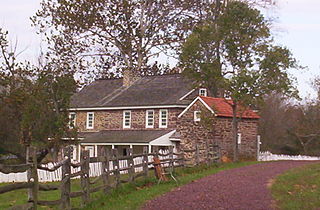
The Daniel Boone Homestead, the birthplace of American frontiersman Daniel Boone, is a museum and historic house that is administered by the Friends of the Daniel Boone Homestead near Birdsboro in Berks County, Pennsylvania. It is located on nearly 600 acres (2.4 km2) and is the largest site owned by the Pennsylvania Historical and Museum Commission. The staff at Daniel Boone Homestead interpret the lives of the three main families that lived at the Homestead: the Boones, the Maugridges and the DeTurks. The park is just off U.S. Route 422 north of Birdsboro in Exeter Township.

The Joseph Slocum House is an historic house on Slocum Road in North Kingstown, Rhode Island. It is a 1+1⁄2-story wood-frame house, five bays wide, with a large central chimney. It faces south on the east side of Slocum Road. The house has been dated to the mid-18th century based on architectural evidence; its first documented owner was Joseph Slocum, in the early 19th century. The house is a rare surviving 18th-century farmhouse, a type once numerous in the town.
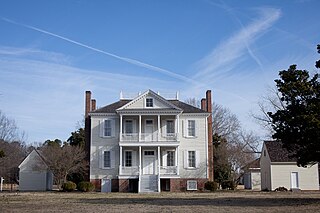
Hope Plantation, built in 1803, is an early house built in the Palladian mode of the Federal style, located on the Carolina Coastal Plain, near Windsor, North Carolina, in the United States. The plantation house was built by David Stone, a member of the coastal Carolina planter class, later Governor of North Carolina and a United States senator. One of the finest examples of Palladian design built in timber, the manor house is slightly modified by neo-classical elements. The facade has five bays and a pedimented double portico with the original Chinese Chippendale balustrade. Crowning the house is a widow's walk with matching railing. The interior of the house displays a height and grandeur rare in the region, and is furnished with a unique collection of period furniture, art and artifacts.
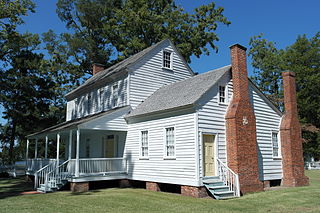
Bonner House is a historic home located at Bath, Beaufort County, North Carolina. It was built about 1835, and is a two-story frame dwelling with a one-story wing and rear shed addition. It sits on a brick pier foundation and has a side-hall plan. It is on land once owned by John Lawson, explorer and founder of Bath.
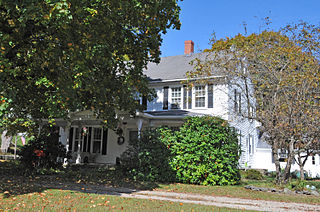
Ashlawn, also called the Joshua Perkins House, is a two-story, central-hall frame farmhouse dating from the 18th century in Hanover, Connecticut. The house's namesake is its first owner, Joshua Perkins, a farmer and son of the prominent Captain Matthew Perkins, a farmer and founding member of the Hanover Society. Ashlawn's main house has a five-bay front facade with pilasters supporting broken-base pediments. The inside has well-documented woodwork for its moldings and wainscotting. The house has integrated an older structure, likely a central-chimney structure built in the second quarter of the 18th century, as an ell.
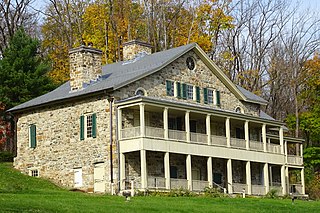
Shippen Manor is located in Oxford Township, Warren County, New Jersey, United States. The manor was built in 1755 and was added to the National Register of Historic Places on December 20, 1984, for its significance in architecture and industry. It was later added as a contributing property to the Oxford Industrial Historic District on August 27, 1992.
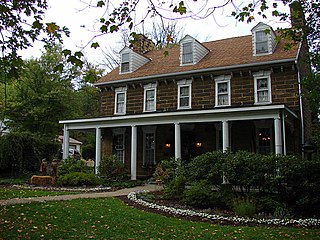
Hill's Tavern is a historic building in Scenery Hill, Pennsylvania. It was heavily damaged by a fire that started shortly before midnight on August 17, 2015. For a period in the early 1900s, the inn was known as Central Hotel. Now called the Century Inn, it has been claimed to have been the oldest tavern in continuous use on the National Road, until the fire brought an end to its 221 years of continuous operation.

The Myers-White House, also known as Sycamore Grove, is a private residence located near Hertford in the Bethel Township of Perquimans County, North Carolina. It is one of the oldest private homes in the state. The exact construction date is not known. It was likely constructed in the early 1700s. Thomas Long (~1730) is assumed to be the architect and builder. It is a 1+1⁄2-story frame dwelling with brick ends and a gambrel roof. It is one of the two known gambrel roof houses with brick ends in the state. It is a member of the small group of 18th century frame houses with brick ends in northeast North Carolina; the group includes the Sutton-Newby House and the Old Brick House.
The Rowan Museum is located in a 19th-century courthouse in Salisbury, North Carolina that survived Stoneman’s Raid. The building is considered to be one of the finest examples of antebellum architecture in North Carolina. The museum is dedicated to the history of Rowan County.

The Clymer House is a historic house at 31 Clymer Road in Harrisville, New Hampshire. Built in 1932, it is a finely crafted example of Colonial Revival architecture, built in conscious imitation of an earlier form that might have occupied the same site. The house was listed on the National Register of Historic Places in 1988.

Freeman House, also known as The Stateline House, is a historic home located on the North Carolina-Virginia state line near Gates, Gates County, North Carolina, USA. The house was built in three building phases, the earliest perhaps dating to the late-18th century. The farmhouse was initially built following the basic early-Federal-style one-room plan, followed by the addition of a late-Federal-style two-story side-hall-plan, which was finally enlarged and converted in the mid-19th century to a more substantial Greek Revival style, center-hall-plan dwelling. The main section is a two-story, five-bay, frame structure. Also on the property are the contributing smokehouse, a kitchen with exterior end chimney, a one-story tack house with an attached wood shed, a small, unidentified shed, two large barns, and a stable.
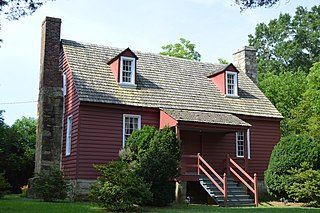
Person's Ordinary is a historic inn and tavern located at Littleton, Halifax County, North Carolina. It dates to the mid- to late-18th century, and is a 1 1/2-story frame dwelling, three bays wide and two deep, with a massive exterior stone chimney at each end. It rests on a stone cellar, and has a modified Quaker plan. The building housed an inn and tavern for stagecoach travelers into the 1830s and is associated with Thomas Person, one of the state's most important political leaders from 1760 to 1790.
Vesuvius Furnace is a historic home and iron furnace located between Denver and Iron Station, Lincoln County, North Carolina. The house was built in two sections the older dated to about 1792, with the western section added about 1810–1820. It is a two-story, five bays wide and two deep, frame structure with a one-story shed porch. The furnace was built in 1790, and is constructed of large stone blocks of random sizes, but about half of the square pyramidal structure has fallen down. The furnace is about 20 feet high and is filled with dirt, debris, and vegetation. Vesuvius Furnace was established by General Joseph Graham, who was one of the chief leaders in the 18th and early 19th century production of iron in Lincoln County, and was the father of governor and as secretary of the navy William Alexander Graham.

The Jugtown Historic District consists of a cluster of historic buildings surrounding the intersection of Harrison Street and Nassau Street in Princeton, New Jersey. The settlement dates to colonial times and is sometimes known as Queenston. In 1987, the district was listed on the National Register of Historic Places.
Daniel Stone Plank House was a historic home located near Henderson, Vance County, North Carolina. It dated to the late-18th or early-19th century, and was a two-story, sawn plank farm house. It was built and altered in at least three periods, and measured 22 feet long by 23 feet deep. It was moved to its listing site about 1885, and featured a gable roof projecting over the vertical plane of the walls on all four elevations. It has been demolished.

Mountain View Stock Farm, now known as Tylord Farm, is a historic estate farm on Vermont Route 22A in Benson, Vermont. Developed in the early 20th century around a late 18th-century farmhouse, the farm was renowned in the state for its breeding of Kentucky saddle horses and Chester White hogs. The farm complex also has architecturally distinctive Colonial Revival styling. The property was listed on the National Register of Historic Places in 1989.




















